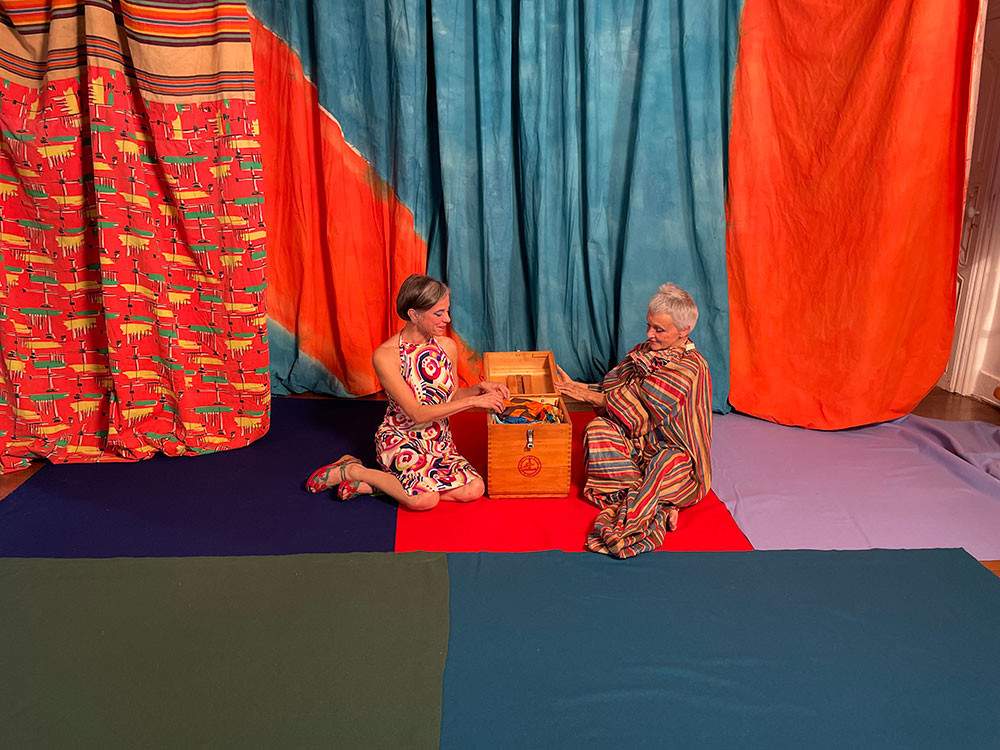In Piacenza, two contemporary artists celebrate Sonia Delaunay and her manifesto dress
From November 24, 2022 to April 16, 2023 XNL Piacenza, the Center for Contemporary Art, Film, Theater and Music of the Fondazione di Piacenza e Vigevano presents On the Dress She Has a Body. Notes on Sonia Delaunay, an exhibition project by Meris Angioletti (Bergamo, 1977) and Ulla von Brandenburg (Karlsruhe, 1974) dedicated to the Russian-French artist Sonia Delaunay, who was born in Odessa in 1885 and died in Paris in 1979. The project curated by Paola Nicolin starts precisely from the invitation addressed to the two contemporary artists to reflect on the figure of Sonia Delaunay and in particular on the adventure of theAtelier Simultané, active from 1923 to 1934, an extension of the house-studio in Paris on Boulevard Malesherbes where Sonia Delaunay lived with her husband.
An artist capable of applying the Futurist project of refounding the world, Sonia Delaunay cultivated a particular aptitude toward the encroachment of abstract painting beyond the frame of the painting, working on the dynamics of colors and their interaction to construct a personal expressive vocabulary often identified with the concept of simultaneity. The artist has constantly investigated the perceptual nature of color, the pure nature of painting, and extends this pictorial position within a dimension that simultaneously involves different disciplines, from painting to design, from fashion to poetry, from film to sculpture to publishing.
In 1913, Sonia makes a dress her manifesto as she entrusts the presentation of her first “simultaneous dress,” constructed through a combination of colors and forms, with the message of an anti-modern, androgynous modernity, neither male nor female, which experiences the body as a laboratory for aesthetic and social research. Among the poets and literary friends of the couple living and working in Paris it was Blaise Cendras who dedicated a poem to the dress, Sur la robe elle a un corps, from which the title of this exhibition is taken.
Angioletti and von Brandenburg are invited to reflect on this episode as an example of research on the identity nature of fabric, on the different translations of pure painting into moving image, voice and space, and on the very idea of art as an open field in which the body acts and acting knows. The proposed dialogue around Sonia Delaunay is thus meant to be an open question to great contemporary interpreters about our time, about the idea of simultaneity as a human-society-space relationship.
The themes of the exhibition are thus fabric and body, poetry and voice, word and gesture, time and space. Both artists, in the respective diversity of their expressive languages, have been working for years on the border between disciplines, questioning the relationships between fabric, poetry, dance, cinema, theater, and sound as tools of social and psychological investigation, transforming rituals, literature, popular culture, theater, and poetry into existential installations conceived above all as sets of possible hypotheses.
An artist and researcher, Meris Angioletti focuses her practice on the relationship between language and the body. Poetry, literature, psychology, treatises on physics and mathematics as well as tarot and rituals are the basis of a research on the visible and invisible, the fragment and the whole, between awareness and unawareness of things. These references are at the center of an art that takes the form of installations and sound tracks, performances, nocturnal readings, choreography, and projections of light, color and images. Voice is privileged raw material for the artist as the work is created through various stages of translation.
Ulla von Brandenburg ’s work, on the other hand, is an example of research into the relationships between fabric and the body. The latter is experienced as a space-creating, space-transforming material that induces “other” behavior and often, in her works, accommodates like a curtain film projections related to performances and staging directed by the artist herself. Film, theater, performance, literature as well as characters from history are elements of a complex discourse that the German artist has over the years skillfully translated into three-dimensional scenarios of color and form.
What Angioletti and von Brandenburg construct together is awork-exhibition consisting of afabric installation and a series of new films and an extensive sound project. The gallery is preceded by a space set up as a time chamber where a selection of Sonia Delaunay’s gouaches from the Gió Marconi Gallery in Milan and a series of materials related to the artist’s poetics are presented.
The exhibition will be accompanied over time by a program of artist ateliers conceived by Meris Angioletti, to reflect on the concept of the museum-atelier, conceived as a place for the interweaving of knowledge and productive workshops.
For info: https://xnlpiacenza.it/
Hours: Friday through Sunday from 10:30 a.m. to 7:30 p.m.
Free admission.
Image: Ulla von Brandenburg, La fenêtre s’ouvre comme une orange (2022) Seventeen painted canvases, tape, rope (dimensions variable) and three super 16 mm films transferred to hd video, color, silent (durations variable, 5 + 2 PA edition). Courtesy of the artist, the Piacenza and Vigevano Foundation and the galleries: Art : Concept (Paris); Meyer Riegger (Berlin/Karlsruhe); Pilar Corrias Gallery (London) and Produzentengalerie Hamburg (Hamburg) Scenographic conceptualization by Julia Mossé.
 |
| In Piacenza, two contemporary artists celebrate Sonia Delaunay and her manifesto dress |
Warning: the translation into English of the original Italian article was created using automatic tools. We undertake to review all articles, but we do not guarantee the total absence of inaccuracies in the translation due to the program. You can find the original by clicking on the ITA button. If you find any mistake,please contact us.





























